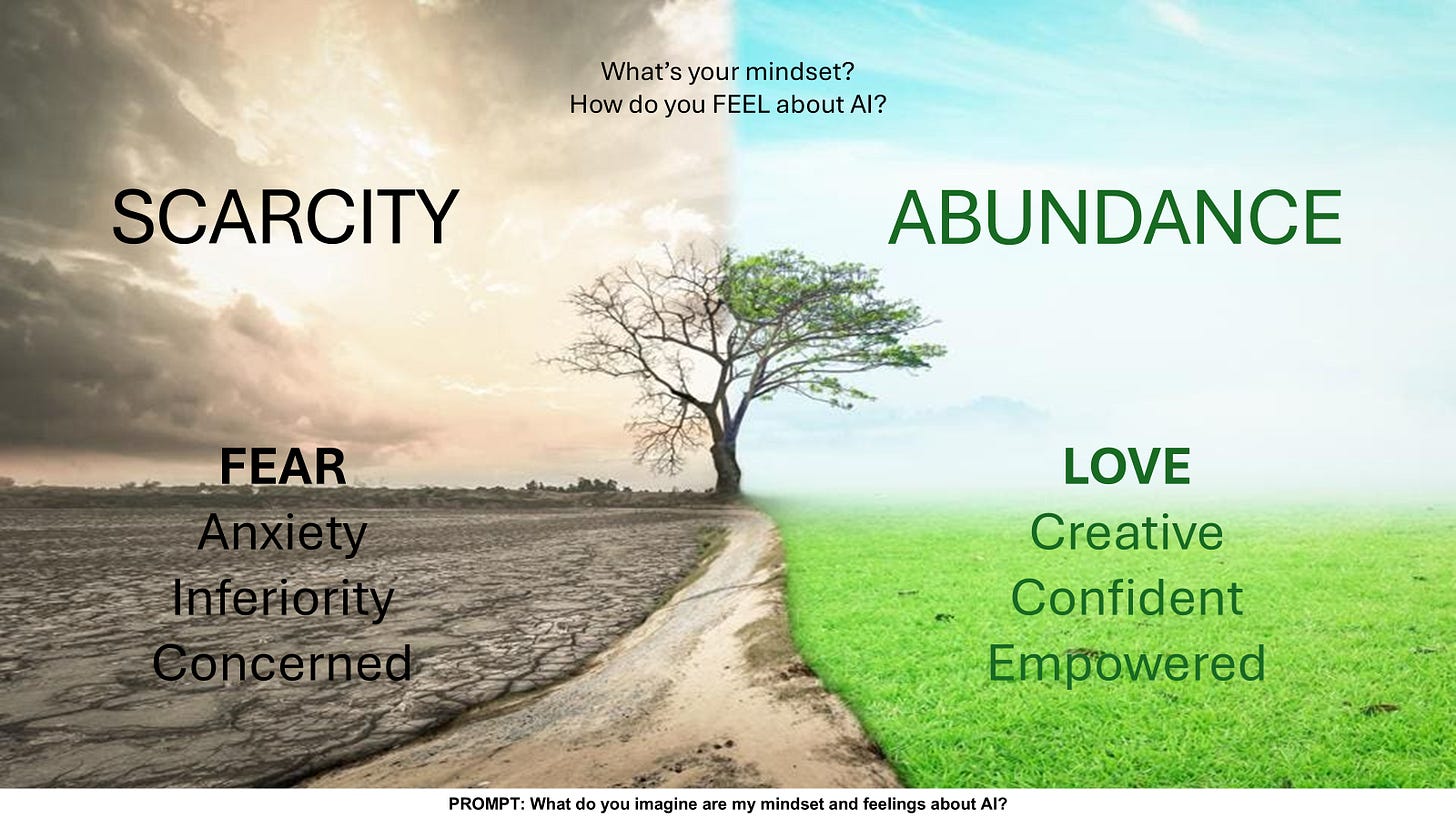You Can't Lead From the Sidelines
Why creating custom AI is what creates AI leaders.
Can you lead a revolution that you’re not participating in?
We’re in the middle of the biggest transformation since the internet—maybe even since electricity was invented.
Yet almost everybody is struggling to fully leverage AI.
While most executives say AI adoption is urgent, many studies show that few companies are getting the ROI they expected.
But the problem isn’t the technology. We all know what it can do.
The problem is that leaders are delegating the AI revolution instead of leading it.
And that’s because of an emotional issue.
Fear & Loathing in AI
In every AI workshop I run, I show this slide:
Then I ask the group how they feel about AI.
Some people light up with excitement. Others tense up with anxiety.
And most people are holding both emotions at once—fascination and fear.
Because there are many valid things to be afraid of when it comes to AI.
And there are also many myths and F.E.A.Rs (False Expectations Appearing Real).
I’ve never seen such widespread anxiety. It’s dizzying.
Here’s what I’ve come to believe:
The first step to winning in the AI age isn’t learning prompts—it’s managing your fear.
Because fear distorts perception. Fear shrinks what you see, and blocks your potential.
And whatever your biggest fear is about AI, the best way to prevent that negative future is to use AI yourself.
Learn to fight fire with fire.
Agency is the antidote to fear.
The Exponential Gap
Right now, AI technology is progressing exponentially: 2, 4, 8, 16, 32, 64, 128...
But in most organizations, adoption is crawling linearly: 2, 3, 4, 5, 6, 7, 8...
The technology can perform at 128.
But the average person and company is using it at an 8.
And this gap starts at the top.
You cannot effectively lead AI strategies if you’re not effectively using AI yourself.
This is fundamentally different from previous technology waves.
In the past, leaders could delegate tech implementation to IT.
But AI doesn’t work that way.
AI isn’t a tool you deploy—it’s a partner you develop.
It’s not software you install—it’s intelligence you integrate into your workflow, your decision-making, your approach.
The easy part is creating an AI strategy or policy.
But that won’t move the needle for your teams.
People need to see you using AI in your own role so they will be inspired to use it in theirs.
They need you to get it.
The Leadership Mirror
People are affected by the emotions of their leaders.
If you carry tension about AI, they’ll carry fear.
If you carry curiosity, they’ll carry courage.
When a VP experiments with AI and shares wins and learnings in team meetings, their direct reports start experimenting too.
When a CEO builds their first custom AI and talks about how it’s changing their thinking, managers across the organization will start building their own.
On the other hand, when leaders talk about AI importance without using it themselves, people get the real message: this isn’t actually a priority.
So ask yourself honestly:
Am I experimenting with AI every day?
Am I using it for my most important work?
Am I changing my habits to be AI first?
Or am I just watching, thinking, and commenting?
Inaction is what gets you left behind.
It’s go time. It’s time to learn AI by doing AI. It’s time for doing.
And like Yoda said: Do or do not. There is no try.
The Amplifier of Custom AI
AI doesn’t stand for Artificial Intelligence.
Think of it as your Amplified Intelligence.
It’s not here to replace you—it’s here to extend you.
It’s a superpower we all have access to, once we learn to harness it for our specific needs.
This isn’t just wordplay. The way you frame AI shapes how you engage with it.
If you see AI as “artificial”—synthetic, fake, a replacement—you’ll keep it at arm’s length.
But if you see AI as an “amplifier”—an extension of your intelligence—you’ll pull it closer.
The breakthrough often comes when you move from using generic AI to building your own custom AI, which utilizes pre-set instructions to operate in specific ways.
Each of the major LLMs have the ability to create custom AI (Project or GPT in ChatGPT, Agent in Copilot, Project in Claude, Gem in Gemini).
I believe that creating custom AIs is the single most powerful feature in the entire pantheon of AI tools.
Cultivate Your Superpowers
Using generic AI is like watching a magic trick.
Developing custom AI is like cultivating a superpower.
When you create your own custom AI, something fundamental shifts.
You’re not just seeing what AI can do—you’re building it.
You’re customizing intelligence to your specific needs, context, and ways of thinking.
You’ve become the architect of your own AI stack.
You see AI as intelligence you can shape, direct, and continuously improve.
And once you’ve built something that amplifies your thinking and productivity, you’ll see use cases and opportunities everywhere.
It’s the surest path to having your AI “aha” moment… where suddenly you get it.
You can lead with confidence because you’re speaking from direct experience.
You understand the mindset shift because you’ve made it yourself.
You know what success looks like because you’ve experienced it.
This is what it looks like to move from AI Dabbler to AI Director.
Stop Watching. Start Leading.
The AI revolution isn’t coming—it’s here.
And right now, the vast majority of leaders are still dabbling.
That’s your opportunity.
You’re not behind. But you’re not ahead either.
The path is simple: Create custom AI for your most important work.
Make it specific to how you think, decide, and lead.
Then use it constantly—not occasionally. For everything that matters.
That’s how AI becomes your superpower. That’s how it becomes second nature.
Your team is watching. They’re ready for you to show them what’s possible.
It’s time to lead.



